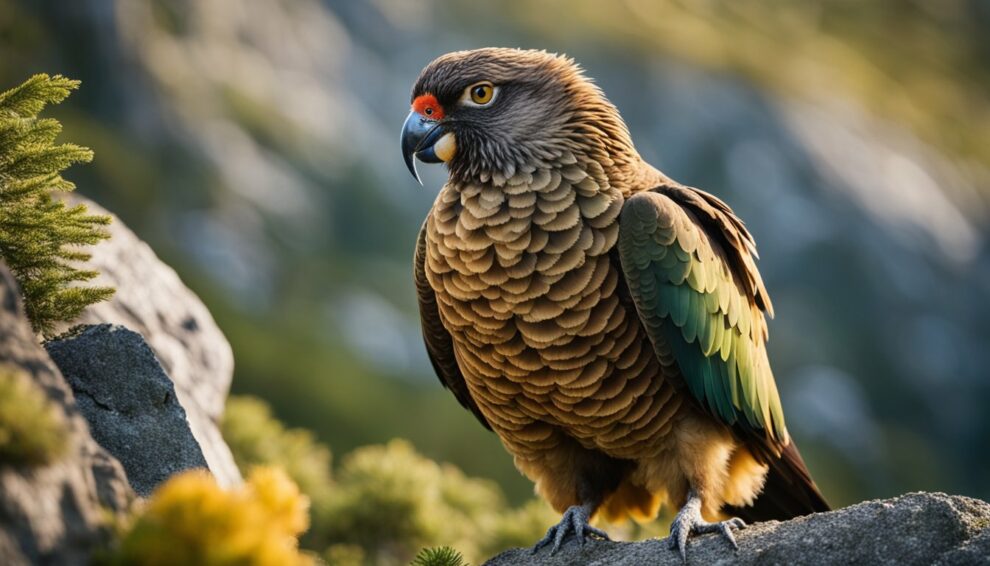Meet the kea, New Zealand’s famously clever alpine parrot, with an appetite as varied as the mountain terrain it calls home.
Like adventure seekers who thrive on a changing landscape, the kea’s diet is a smorgasbord of opportunity, making it a true reflection of its alpine habitat.
These curious birds, with their striking green plumage and playful antics, are as unique as the land they inhabit.
Equipped with a sharp beak and an even sharper mind, they peruse the South Island’s diverse buffet, from juicy berries to scavenged delicacies left by less careful visitors.

Can you imagine having a meal high up in the chilly mountains one minute, and then swooping down to sample some delicious insect or sweet nectar the next?
For the kea, this isn’t a daydream; it’s daily life! They munch on seeds, flowers, and insects when the sun is out and the weather is kind.
And when opportunities arise, they might indulge in a cheeky bite of a tourist’s sandwich—after all, who wouldn’t want a free lunch?
With the kea’s ever-changing menu, it’s fascinating to think how each morsel plays a part in their survival.
It’s not just about the food; it’s about being smart and adaptable.
The high-flying antics of the kea are not just for show; they reveal a survival strategy that allows them to thrive in an environment where every day is different and every meal is an adventure.
So, next time you’re enjoying your lunch, think of the kea and the mountainous feast they explore every day!
Kea Habitat and Lifestyle

Deep in the heart of New Zealand’s rugged landscape, the kea, a parrot with a penchant for high altitudes, has made the Southern Alps its playground.
Let’s explore the world of this mountain-dwelling bird, where family and adventure go hand-in-hand.
Home in the Southern Alps
The Southern Alps of New Zealand’s South Island offer more than just breathtaking views; they are the kea’s primary residence.
With Nestor notabilis as their scientific name, these intelligent birds find comfort in forests near the snowline, thriving in the alpine and subalpine zones.
In these chilly heights, far above where most trees dare to grow, the kea’s curiosity and resilience are as clear as the mountain air.
Social Bird Dynamics
In the nippy alpine environment, keas form tight-knit social structures, often observed in dynamic family groups.
The social interactions among keas are a sight to behold, and their monogamous nature adds an extra layer of intimacy within the flock.
Conversations between keas are a mix of playful banter and serious business, strengthening bonds and maintaining the social fabric that’s central to their survival.
The Juvenile Journey
What about the young fledglings, you might wonder?
The juvenile kea embarks on a significant journey from the fledgling stage to learning the ropes of mountain life.
Growth in the kea community is a communal effort with older birds often spotted teaching the youngsters the ways of the forest and mountains.
It’s during this time that the juveniles expand their diet, learn to navigate the harsh landscape, and figure out where they fit within the kea’s alpine kingdom.
As they wing from peaks to valleys, keas continue to capture our imaginations with their aerial acrobatics and mischievous antics.
The next time you find yourself gazing up at the majestic Southern Alps, remember that those high reaches are not just made of rock and snow but are also home to a world of feathery innovators, the kea.
Diet and Foraging Patterns

The kea has a diverse and adaptable feeding strategy, which enables it to survive in the harsh alpine environments of New Zealand’s South Island.
Here, the kea’s approach to meals is driven by opportunity and necessity.
Omnivorous Appetites
Keas exhibit remarkably omnivorous diets, with food choices varying based on availability and season.
These birds are known to consume a wide array of seeds, which provide them with vital nutrients.
Throughout the changing seasons, the kea’s diet adjusts, incorporating fruits and nectar when they can be foraged.
They also have a penchant for invertebrates, which they skillfully unearth from under the bark of trees or from the soil—feasting on this protein-rich fare offers the kea essential sustenance.
Scavenging is another aspect of their food-seeking behavior. These parrots, when the opportunity arises, won’t shy away from a meal of carrion.
They’ve been witnessed inspecting and consuming the remains of sheep in the highlands, displaying their adaptive foraging behavior.
This variation in their diet reveals their ability to exploit numerous food sources, making them a unique spectacle in the world of avian species.
Kea and Human Interaction
Interaction with humans has introduced new elements into the kea’s diet.
In areas frequented by people, these intelligent birds often approach vehicles, driven by curiosity and the potential of food.
Instances have been reported of keas investigating cars, likely associating them with the easy access to snacks left by tourists.
This interaction, while a display of the bird’s cunning, has its downsides.
Sheep farmers have had their clashes with the kea, due to the parrot’s occasional predation habits which bother livestock.
Such encounters have had a profound impact on how keas forage, influencing their diet, and bringing them into direct contact with human activities.
Through necessity or curiosity, the kea continues to adapt its diet and foraging methods in a changing world.
Whether unearthing a nutritious morsel or engaging with human visitors, these birds exhibit a fascinating approach to feeding in their alpine habitat.
Conservation Efforts and Predator Challenges

The future of the kea, New Zealand’s alpine parrot, hangs in a delicate balance with conservationists working tirelessly to protect these birds from predators and human impacts.
Their status as nationally endangered shows how urgent these efforts are.
Protecting the Kea
The Kea Conservation Trust is at the vanguard of conservation efforts, aiming to safeguard the future of these intelligent birds.
They are protected by law, but this alone is not enough to ensure their survival.
Conservationists monitor kea populations, rehabilitate injured birds, and raise public awareness about the importance of these unique parrots.
They also create safe habitats to enhance their chances of survival.
By keeping track of the kea’s numbers and health, we can tailor conservation strategies to better protect these treasures of the mountains.
Battle Against Predation
Imagine facing threats every single day; this is the reality for kea.
Introduced predators like stoats and rats pose serious challenges to these endangered parrots.
The predators attack vulnerable kea eggs and babies, significantly reducing their populations. Heartbreaking, isn’t it?
To combat these threats, conservationists deploy predator control measures such as traps and poison to reduce the numbers of these invasive species.
Every stoat or rat removed is a beacon of hope for the kea’s future.
Through these actions, the kea stands a fighting chance against the predators that threaten their existence.
Understanding Kea Behaviours

In the rugged terrain of New Zealand’s South Island, Kea behaviours exhibit a fascinating display of intelligence and novelty-seeking that captivates scientists and bird enthusiasts alike.
Intelligence and Playfulness
Keas are the Einsteins of the avian world, showcasing incredible smarts that rival primates in their puzzle-solving abilities.
They demonstrate a remarkable gift for problem-solving and tool use, which is quite rare in the bird kingdom.
It’s not merely about survival for these parrots, their playfulness is apparent as they slide down snowy slopes or play catch with twigs.
Their inquisitive nature often leads them to explore and manipulate their surroundings with an almost child-like curiosity.
This zest for playful exploration makes the kea a symbol of wilderness in New Zealand and reflects a high level of intelligence that teases the minds of those who study avian species.
Conflicts with Humans
While their curiosity is endearing, it sometimes gets keas into trouble with humans.
Interaction with people has led to keas developing a taste for human food and even causing damage to property, including peeling rubber seals from parked cars.
Farmers have had their conflicts with keas, for they were once believed to attack livestock, leading to a tragic history where keas faced a government-sanctioned bounty.
These intelligent birds paid with their lives, significantly reducing their population until they were recognized as a protected species.
Despite past conflicts, increased understanding of kea behaviours has helped foster better human-kea relationships, flipping the narrative from pesky troublemakers to wondrous creatures needing protection.
Frequently Asked Questions

Exploring the eating habits of Kea parrots is like uncovering the secrets of a feathered Houdini.
These parrots have some clever tricks up their wings when it comes to finding and enjoying their food in the wild alpine environment of New Zealand.
Let’s answer some burning questions about these remarkable birds.
How do Kea parrots adapt to their alpine environment?
Kea parrots thrive in the chilly heights of New Zealand’s mountain ranges.
To survive in such a demanding climate, they’ve developed a thick layer of feathers and the ability to eat a varied diet.
This flexibility in their eating habits helps them to make the most of the resources available in their alpine home, ensuring they have the energy to stay warm and active.
Can you tell me about the problem-solving skills of Keas?
Certainly! Keas are known for their impressive problem-solving abilities, which they put to use while foraging.
They can manipulate objects and use strategies to access food, demonstrating intelligence that’s quite extraordinary for birds.
This knack for figuring things out helps them unlock new food sources, making them adept at survival in the wild.
What kind of habitat do Keas live in within New Zealand?
These parrots call New Zealand’s South Island home, favoring the forested and mountainous areas.
Keas are particularly fond of the alpine and subalpine zones, where they frolic amongst the rocky outcrops and snow-capped peaks, creating a playground out of the challenging landscape.
In what ways does the Kea’s diet vary from other parrots?
Unlike their tropical cousins who feast on fruits and nuts, Kea parrots have a more eclectic palate.
They munch on a mix of plants, seeds, and even animal protein, like insects and carrion.
This opportunistic diet sets them apart and enables them to adapt to the scarce offerings of their alpine habitat.
Are Kea birds considered to be a threatened species?
Yes, Keas are indeed considered a threatened species.
Due to predation by introduced mammals and human impacts like lead poisoning, their numbers are dwindling.
Conservation efforts are in place to protect these intelligent creatures and their unique mountain environment.
How do Kea parrots interact with other species in their ecosystem?
Interaction between Keas and other species varies from peaceful coexistence to opportunistic feeding.
These resourceful birds often search for food left behind by others and may influence the lives of smaller alpine animals by competing for shared resources.
Their presence in the ecosystem is a puzzle piece that fits into the broader picture of New Zealand’s wildlife dynamics.









